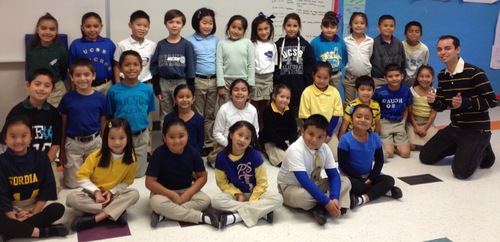
The First-Year Waltz
by Rhandy Siordia, Second Grade Teacher
Teaching is more learning than teaching. As a new teacher, I spend most of my time “learning to teach” when in fact it should be the other way around; it should actually be “teaching to learn,” because teaching as an act is essentially just one part of the learning process.Every day I am learning from my teaching. I am learning how second graders think and react to situations, learning how to explain concepts in a way that strikes that perfect, fleeting balance between accessibility and true rigor, and learning to cope with stress and critical feedback that although might sting in the moment, only pushes me to higher levels of capability.
I thought I had experienced stress before becoming a teacher. I thought I had worked harder, longer hours than anyone in the world, and I prided myself on doing what I thought was defeating the impossible with fiery confidence every day.
Stepping into the world of teaching felt no less shocking than a bucket of ice water to the face. Indeed, I had faced stress before but had frequently figured out how to shimmy my way through challenging situations with poise, conviction, and success. But teaching was no shimmy. Teaching was a relentlessly intricate ballroom waltz, wherein every single move needed to be choreographed then practiced over and over, until the only thing left was flawless execution.
I watched as my idea of excellence transformed from a distant, grandiose goal to a personal expectation and norm. A goal is something you work towards; you aim at, you strive for. A norm is something you do—every day. I found the best way to reach excellence was to grab it out of the sky and hold it close, so that it became a part of me—who I am. I knew for a fact that I was going to become an excellent teacher. I knew because as long as I was determined enough and maintained an unbeatable work ethic, nothing would stand in the way of success, and not even the sky would be my limit. People that stopped at the sky are weak.
Then you slip. You slip and you fall through the sky and land flat onto that ballroom floor. You fall hard, it hurts, and you take your partner down with you.
Go ahead, turn and talk to your partner. Talk to your waltz partner about how it was their fault and how you wouldn’t have mis-stepped if they hadn’t caused you to lose your balance. Talk to your partner about how you’ve spent countless hours practicing and didn’t deserve to slip, how it wasn’t fair. Talk about the guilt you feel for letting the room full of dancers down. But they’re not dancers…they’re children. And you look around your classroom and see that you are your partner, and that you yourself are responsible for improving.
I am often surprised at how long it takes people to realize that such sentiments are in fact self-reflections. Some fail to grasp that the intricate waltz occurs between yourself and yourself, the teacher and the learner. One can’t achieve motion without the other; the two are intertwined yet distinct. There is no teaching without learning how to teach, as grossly oversimplified as that may be. There is no meaningful learning without practice in the classroom. To whoever writes the “Teaching for Dummies” books – you’ve totally missed the point.
Needless to say, I have learned countless skills and techniques since I started teaching. I now know how to plan an engaging lesson, differentiate instruction across varying skill and engagement levels, and secure discounted drinks at Starbucks with endearing stories about 7-year-olds. But there is one thing about the world of teaching that every teacher, first-year or veteran, needs to remember:
Just keep dancing.
—-
Rhandy Siordia teaches second grade on the founding team at Spark Academy in San Jose, CA. He graduated from University of California, Santa Barbara with a BA of Psychology. Rhandy was born in San Jose and spent his first few years in the neighborhood where Spark Academy is now located.
Published on December 14, 2013
Read more stories about: Teacher Experience.


